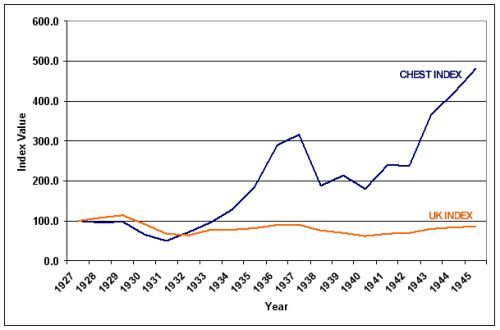Original Post:
Some years ago I got into an argument with a hotshot money manager about John Maynard Keynes' investment performance. The MM insisted that during Keynes' time as bursar of Kings College, Oxford he had increased the college's endowment ten fold.
I didn't know the actual numbers but this struck me as high, at a time when most endowments were invested in property and fixed income securities. I decided I didn't much care for the MM when he said he couldn't give me a citation for his assertion and decided to find the numbers.
Then promptly forgot about the question.
Last year, when it seemed that everyone had become a Keynes expert I thought I should read his "The General Theory of Employment, Interest and Money".
(here's an online version at Marxists.org [!])
It's a heavy slog but now it takes strangers longer to recognize my mental resemblance to Homer Simpson ("Stupidity got us into this mess and stupidity will get us out."; "I'm not a man who's easily impressed. Hey, a blue car." etc.).
More interesting to me was a return to the money manager's assertion, which meant biographies and typing. Luckily, MaynardKeynes.org has put some of the material online so I can copy and paste rather than get all qwerty on you.
First up, a couple snippets from the one page piece "Keynes The Speculator":
John Maynard Keynes began his career as a speculator in August 1919, at the relatively advanced age of 36 years.
Keynes traded on high leverage - his broker granted him a margin account to trade positions of £40,000 with just £4,000 equity....
You know where this is going don't you:
Here are some snips from the slightly longer "Keynes the Money Manager":...Keynes soon learned that short-term currency trading on high margin, using only his long-term economic predictions as a guide, was foolhardy. By late May, despite his belief that the U.S. dollar should rise, it didn’t. And the Deutschmark, which Keynes had bet against, refused to fall. To Keynes’s dismay, the Deutschmark began a three-month rally.
Keynes was wiped out. Whereas in April he had been sitting on net profits of £14,000, by the end of May these had reversed into losses of £13,125. His brokers asked Keynes for £7,000 to keep his account open....MORE
...His policy of selling properties and using the proceeds to “speculate in the stock market” was opposed by many of King’s College’s fellows. Keynes’s view was that he would rather be a “speculator” in an asset that had a daily price quotation and was liquid enough to be bought and sold than an “investor” in something whose price was largely unknown....
...The Chest’s initial capital was £30,000. By the time Keynes died in 1946 the fund had grown to £380,000 - an annual compounding rate of just over 12 percent. This might not seem very remarkable but for the facts that:
So I give half an apology to the money manger, and a thank-you.
- This performance was achieved during a period that encompassed both the crash of 1929 and the build up to World War Two, both of which proved disastrous for British stocks.
- In the same period of time, the British stock market fell 15 percent.
- The growth in the value of the Chest Fund was entirely due to capital appreciation. There was no dividend reinvestment because Keynes spent all of the dividends on the college. He believed the fund was there to provide money for the college and was scornful of the way other Cambridge colleges managed their finances, referring to them as “savings banks”.
The performance of Keynes’s fund from 1927 to 1946 is shown below. During these years the Chest grew at an annual compounding rate of 9.1 percent while the general British stock market fell at an annual compounding rate of slightly under 1 percent.
Chest Fund Performance 1927 to 1946
Keynes did have a ten bagger.
It wasn't the entire endowment, it was a sidecar of the endowment, but the question was worth checking into.
If you want to poke around at Keynes.org, here are some of their pages:
